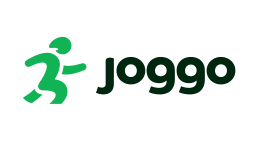Table of Contents
- Joggo combines a weight-loss program with exercise and weekly meal plans to help users develop and maintain healthy habits.
- Prices for Joggo range between $33 and $66 for two, four, or six-month plans. Joggo does not offer a trial period. You may add an additional subscription for $1.99 per week for more guidance on muscle strengthening and recovery.
- The app emphasizes consistency and habit tracking more than calorie counting, and we found it to be a good weight-loss tool for people interested in prioritizing healthy lifestyle changes.
We know that sustained weight loss may feel difficult to accomplish, but the best weight loss programs provide a more structured approach to success. Joggo, a run-tracking app, combines a weight loss program with tailored exercise regimens and weekly meal plans, making it ideal for aspiring joggers and runners. If running a 5k has been an elusive goal, this running app could help you get there. The Handbook Team also likes how it offers education and guidance to people of all fitness levels, helping them to establish good exercise and nutrition habits.
Diets and meal plans are the primary focus of many weight loss programs. Still, the Centers for Disease Control and Prevention (CDC) recommends adding regular physical activity to your healthy living routine for long-term results. Physical activity can increase the calories you burn to help you lose weight. More importantly, it can improve your overall health and positively impact your self-esteem, which can also help you stay on track during your weight loss journey. Joggo can be a great option for those interested in building a running regimen to lose weight and improve their health.
Read on to learn more about Joggo and why our Handbook Team considers it a good (though not perfect) option for establishing better eating and fitness habits during your weight loss journey.
For me, exercise is a big indicator of my mental health. When things get busy, I tend to get sluggish and won’t work out, and then my mental health plummets. It’s definitely tied together.
Focus group participant
HelpGuide Handbook for Joggo
Here are the five most important things to know about Joggo.
Our testing experience




We, the Handbook Team, subscribed to Joggo for two weeks, interacting with its running program and using the meal planning interface. To get an in-depth experience, we completed our prep work, followed our own personalized training regimen, and prepared food using the meal plans provided. This included:
- Completing the onboarding questionnaire.
- Engaging in daily workouts, either outdoors, in the gym, or at home.
- Shopping for ingredients and cooking recommended meals.
- Reading educational materials on nutrition and injury prevention.
- Logging our food, workouts, and weight for in-app tracking.
We also consulted with doctors, dieticians, physical therapists, and weight loss specialists about the platform to further understand if Joggo’s meal plans and workouts were realistic and sustainable.
A good weight loss program will include recommendations for both diet and exercise. No amount of exercise is going to make up for a poor diet. However, exercise is very important for heart health, building muscle and bone strength, and mental health.
Sarah Stombaugh, obesity medicine physician
As we evaluated this app, we wanted to ensure we gained perspective from real people looking for weight loss solutions by hosting a focus group to discuss common obstacles they faced during their journey. We also surveyed 600 people who have participated in weight loss programs to understand what was most helpful and what wasn’t.
According to our survey
According to our survey, the top five most important goals other than weight loss were learning to eat healthier, tracking progress, establishing healthy habits, building motivation, and working out more. Joggo fulfills each one of these goals, making it a great guide towards sustainable lifestyle change.
Learn more about our healthy living review methodology.
Joggo at a glance
Joggo is an exercise-centered health and fitness application available on the App Store and Google Play. When you subscribe to the brand’s two-, four-, or six-month plans, ranging from $33–$66, you get weekly meal plans and bi-weekly customized training regimens designed to help you reach your fitness and weight loss goals.
We had mixed impressions about Joggo when we initially signed up. We thought the pre-registration questionnaire provided unrealistic weight loss expectations. But once we started using the app, we got a completely different impression. We like how it emphasizes consistency and habit tracking more than calorie counts.
While the weight loss app does list the calories you eat and burn, it doesn’t compare your totals to any particular goal. Instead, Joggo tracks your behavior and whether you’ve stayed on track with your plan. For example, the app encouraged us to eat all allotted food for the day by flagging skipped meals in our log. We also like that you can track your weight over time, but you don’t feel pressure to log it daily (like Noom). Research shows that frequent self-weighing can lead to decreased self-esteem and increased anxiety and depression.
Pros and cons of Joggo
What we like
- Emphasizes behavioral change rather than calorie counts.
- Tailored running or walking program to your current ability.
- A customized (and delicious) meal plan that closely aligns with your preferences.
- Plenty of educational resources, including injury prevention education.
- Offers an Apple Watch app for more accurate and convenient data tracking.
- Good overall customer satisfaction, according to our survey.
What we don’t like
- Unrealistic goals set by the initial onboarding process.
- No thorough medical screening, coaching, or clinical support.
- Can’t log your own meals.
- Hidden pricing.
- No trial period.
How does Joggo work?
Onboarding
Before subscribing to Joggo, you are required to take a 15-question survey (or 21 questions if you personalize your meal plan) describing your current behaviors and future goals to determine what your overall plan might look like. In addition to your weight, height, and age, you’ll disclose information about your current activity status and medical conditions, like heart conditions or diabetes. If you answer “yes” to a meal plan, you’ll also disclose your allergies and food preferences to individualize your plan.
Our team loved how detailed and customized the questionnaire felt until we reached the results page. One team member disclosed her results were worrisome, promising a 6-pound weight loss in a week. The CDC states that losing 1–2 pounds per week is healthy and more sustainable, so this result was disappointing to see.
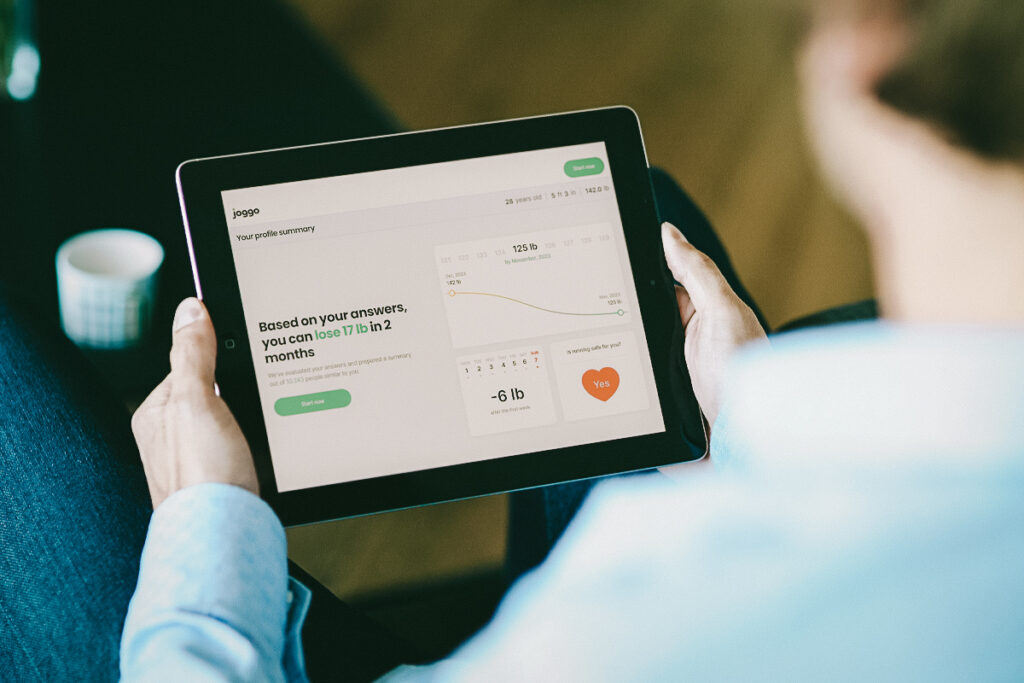
We also tested how well the app flags medical conditions before signing up. No matter how we answered the survey, running was always deemed safe, even if we flagged a heart condition, asthma, and diabetes. This is potentially dangerous for some participants. Chris Alvarado, cardiac program specialist at Queens Medical Center in Honolulu, Hawaii, told us that individuals should first consult with their health care provider before starting an exercise program if they:
- Have a known or suspected cardiovascular disease or other heart condition.
- Exhibit symptoms such as shortness of breath, chest pain, dizziness, or fainting at rest or during physical activity.
- Have high blood pressure, diabetes, or a lung disease.
- Are diagnosed with other health conditions, like kidney disease, liver disease, or musculoskeletal issues.
The results page also shows a body change estimation and daily calorie recommendations. We dislike the body change estimation because it’s a generalized depiction of how the body might transform, but the numbers aren’t descriptive and it doesn’t account for variations in body type. It sets unclear body image expectations from the start, which can lead to more disappointment when you don’t meet Joggo’s lofty goals.
Although every weight loss plan requires a reasonable amount of restriction, the maximum weight loss daily calorie recommendation seems very low in some cases (see image below). One female tester’s survey result recommended 1,120–1,270 calories per day. According to research, a woman who eats 1,200 calories daily may lose weight in the short term, but in the long run, it’s difficult to maintain and slows the metabolism.
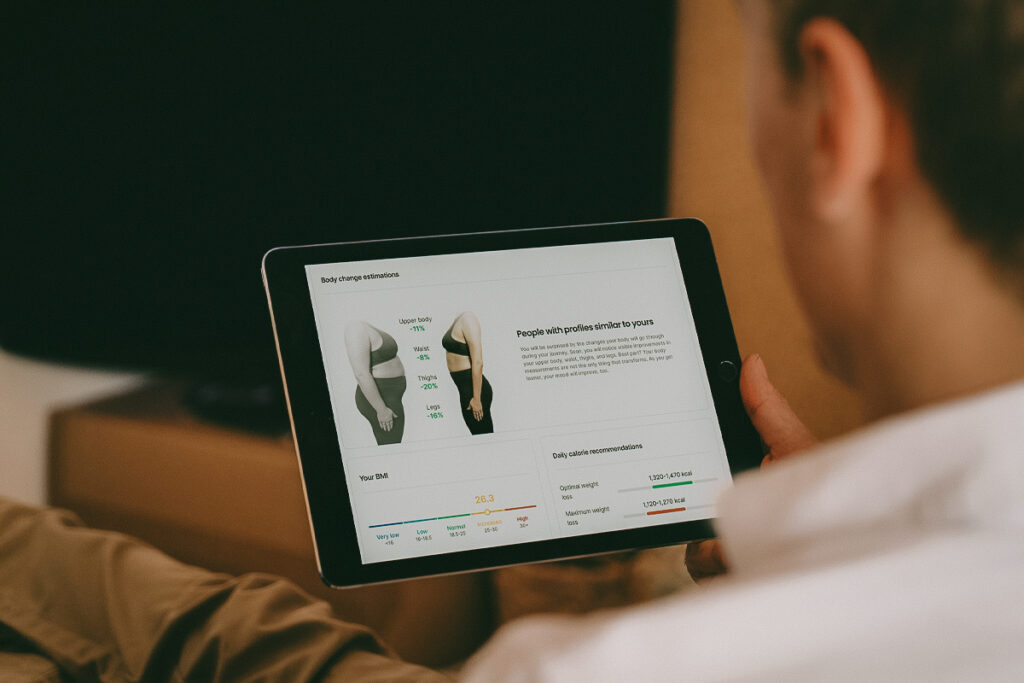
Lastly, we noticed the results page provided our body mass index (BMI) based on our height and weight. Many researchers, medical professionals, and weight loss programs use this standard assessment tool to evaluate your risk for diseases that occur in overweight individuals (like diabetes), but it doesn’t account for the weight of muscle, so muscular people are often miscategorized as overweight. While it helps you get an idea of someone’s potential health risks, it’s not useful in assessing progress as you lose fat and gain muscle during a fitness program.
Set up
We were relieved to discover that only some of those initial onboarding results were worked into our weight loss program as goal markers. Our target weight goal was the primary measure of success, which was more realistic than BMI. We also liked that each day’s calorie intake reflected our optimal weight loss recommendation rather than the maximum weight loss recommendation, so the meal plan felt realistic.
From our tester
“Joggo doesn’t let me add my own meals, but it does let me exchange a meal for a different one on their list. The calorie intake was flexible so long as I was eating its healthy meal recommendations.”
To set up the app, one of the first things you need to do is perform an initial workout to determine your starting point and build your customized plan. We loved how the app caters to walkers and runners alike, welcoming any fitness level to start where they’re most comfortable. During the first workout, you’re expected to run or walk for 10–30 minutes at your own speed. We liked that the app speaks to you through your earbuds throughout your first workout, guiding you through postural control, teaching you breathing techniques, and setting a positive mindset.
The safest and most sustainable form of exercise for most people is just walking! It requires little skill, and you can do other things while walking to make the time pass more quickly, like listening to a podcast or watching a television show.
Katie Rickel, clinical psychologist and CEO of Structure House, a residential weight management program in Durham, North Carolina.
Once you complete your first workout, your plan is immediately created and added to the app. You’re awarded a walking or running level corresponding to an appropriate two-week training regimen, prioritizing running, strength training, and injury prevention. It also gives you an expected two-week goal. Our tester was placed on “Level 7 Advancing Jogger,” which focuses on strengthening and boosting speed in preparation for the next level. She was expected to run 2 miles in 30 minutes by the end of the two-week plan, which she felt was realistic. Joggo determines if you’ve met the goal by assessing you at the end of the two weeks, and if you haven’t, you’ll stay at your current level until you’re ready.
Finally, you need to grocery shop to begin Joggo’s weight loss program. One of our favorite features about the app is how it converts the entire week’s recipes into one big shopping list, allowing you to check off each item as you go. Each item was easy to find at the local grocery store with the exception of a few special ingredients, like hemp seeds or powdered soy protein. Many items, like produce or dry legumes, are generally affordable and available year-round. There were some costly items, like almonds and walnuts, but they often lasted a long time due to small serving sizes throughout the meal plan.
From our tester
“I loved the shopping list, but it’s frustrating that I can’t view my list for future weeks to plan ahead. It will only generate my current week’s grocery list.”

Logging your workouts
Your two-week training plan consists of running and strengthening workouts designed to progress you to the next level and meet your fitness goals. Runs were scheduled on the running days we selected during our quiz (which you can change at any time in your settings), and other workouts were optional. Each completed run day counted toward our running streak, which encouraged us to stay on track. The optional workout days consist of lighter exercises to stay moving, like active stretching or a bodyweight strengthening circuit. We liked that you can also log a free run (your own self-paced running workout), but it doesn’t replace your programmed run for the day (meaning you can log two runs in one day).

Jennifer Lewis, a physical therapist at Resilient PT and Performance, frequently treats and trains runners of all levels. “If you are entirely new to running, you may choose to have a rest day between sessions, but it’s not always necessary to avoid injury,” she says. “The majority of running injuries occur when weekly mileage is increased too quickly. When it comes to taking a rest day, a good rule of thumb is to listen to your body. Some muscle soreness is normal when starting a new running plan, but things like frequent muscle cramping or just feeling exhausted typically indicate that it’s time to take a break.”
From our tester
“I liked that I could adjust my running schedule under my profile. If I looked ahead at my week and noticed that my selected running days weren’t possible, or if I needed more rest days, I could adjust my program accordingly.”
We were also happy to see guided warm-ups that prepared the heart and muscles for activity and cool-downs so the body can settle and recover. However, we wished Joggo offered modifications to exercises, suggesting ways to make them easier or harder. For example, we noticed there were no weighted exercises on the app at all. While bodyweight exercises require minimal equipment, challenging your muscles with more load can build strength that supports longer, faster runs with less injury risk. “This doesn’t always have to be in the form of more weight, though. One way to challenge your muscles adequately is to add ‘tempo’ to your strength training workouts, which means performing them slowly to make the muscles work harder,” says Lewis.
Some running workouts are designed to be more intense than others. We like that Joggo uses your heart rate to determine how intense your workout should be, which you can easily reference in the workout’s informational icons. To get the most out of your program, we think it’s best to use Joggo’s Apple Watch app or reference a different wearable device that tracks your heart rate, so you can determine when to push and pace yourself.
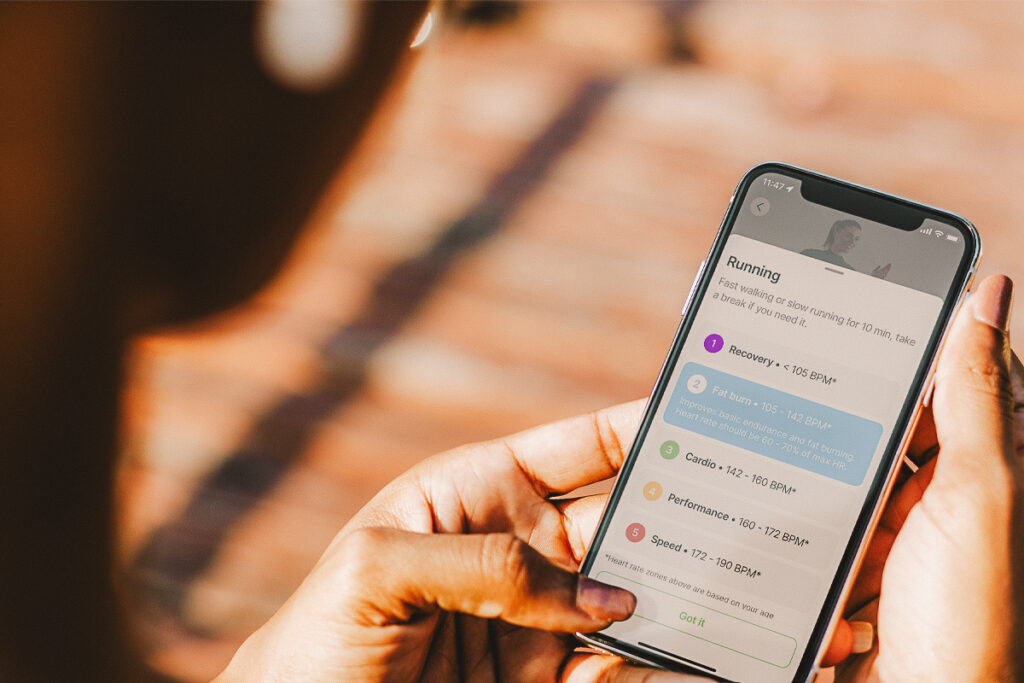
Handbook Tip #1
Don’t get hung up on the “fat-burning zone.” According to Chris Alvarado, cardiac program specialist at Queens Medical Center in Honolulu, Hawaii, it’s believed that a moderate-intensity heart rate zone burns more fat than carbohydrates as its primary fuel source. But this doesn’t mean you’ll shed all of your fat stores and maintain all your muscle if you stay in this zone. The most effective way to burn fat and retain muscle mass is by including a combination of exercise routines with varying intensities. We like how Joggo varies its workouts often, so make sure you abide by the recommended heart rate zones for the best results.
Your workout is logged in your profile after it’s completed. If you run outdoors, it uses built-in GPS tracking to log your pace, distance, elevation gain, and calories burned. Unfortunately, we noticed that the pace tracker wasn’t accurate while running phone-in-hand. And if you run indoors, you’ll have to manually log those details from the treadmill or a wearable tracker because the iPhone’s in-app GPS doesn’t detect treadmill workouts. Our team recommends using an Apple Watch or another wearable tracker to more accurately document running data for Joggo’s platform.
Completing your meal plan
Joggo lets you select your eating preferences to tailor your meal plan. The app will ask about your likes, dislikes, and allergies before formulating your meal library. And once you’re signed into Joggo, you get plenty of easy-to-make recipes that closely align with your preferences.
We loved the recipes Joggo provided us. Many were Mediterranean-inspired dishes that took about 30 minutes or less to prepare. We also loved that many dishes use similar common ingredients, so it’s easy to shop without searching for too many one-off items. Or, if you want to swap one meal for another after you’ve shopped, you’ll likely find a new dish with ingredients you already have. This made it easy for us to stick to the nutrition plan, which is the most important part of a weight loss journey, according to Katie Rickel, clinical psychologist and CEO of Structure House, a residential weight management program in Durham, North Carolina.
“Nutrition will always be king when it comes to weight loss. What might be burned in an hour on a cardio machine can be eaten in seconds at the dining room table. It is unusual that only engaging in exercise will make a significant difference in one’s weight loss efforts,” she says.
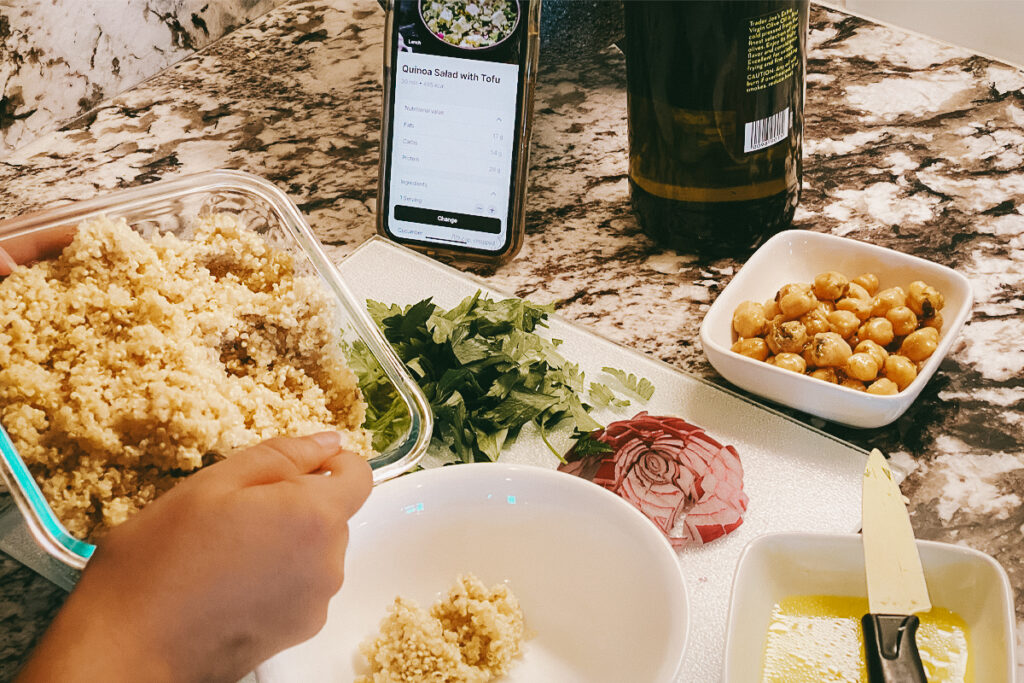
After our testing, we identified just two negatives about the meal log:
- Joggo doesn’t offer the flexibility to document your own meals, which can be frustrating if you’d like to log food eaten outside of the house. However, we also felt this could improve program adherence.
- You can’t backlog meals, so if you forget to document your dinner, you can’t fix it the next morning. This was inconvenient to us because it’s easy to forget to log all meals and snacks every day.
From our tester
“At first, I really didn’t like how Joggo doesn’t let me log my own meals. But when I ask myself why, I realize it’s because I’m used to calorie-counting my every meal as a success marker: If I’m below my daily calorie budget, I’m losing weight. But I think Joggo challenges me to think in a more sustainable way, prioritizing healthy choices over calorie cuts.”
Education and support
Joggo offers an entire section of the app dedicated to educational articles about health and wellness, which discuss the following:
- Getting started: This blog section provides small tips and tricks on what’s best to wear while working out, how to work on running technique, and the importance of particular workouts or rest days for general progress.
- Food and nutrition: Most of the education defines macronutrients and micronutrients, describes how to eat before and after exercise, and explains electrolyte intake.
- Health and safety: Joggo spends time explaining common runner’s injuries and how to prevent them.
We appreciate how Joggo dedicates a section to injury prevention and safety tips. Other weight loss programs we’ve tested don’t offer preventive education, which is an important component of establishing good exercise habits and maintaining progress over time. Topics on common runner’s injuries, like plantar fasciitis and shin splints, are thoroughly covered with medically accurate tips to keep these issues at bay. Joggo also offers insight into how these conditions are treated, but we encourage you to see your doctor or a physical therapist to diagnose and rehabilitate any injury properly.
At the time this review was written, Joggo didn’t offer regular support from clinicians or coaches who understand your specific program and health status. If you have a condition that requires medical clearance, like heart disease or a metabolic disorder, we caution you against using Joggo without talking to your doctor about additional guidance.
If you have questions about using the app, Joggo offers an “Ask a question” function, where you can find additional resources or chat with a live agent, available 24 hours per day, seven days per week. When our tester reached out, we got specific and helpful answers to our questions in about two minutes every time. You can also contact Joggo by emailing [email protected].
Key features of Joggo
Here are the standard app features that come with every Joggo subscription:
How much does Joggo cost?
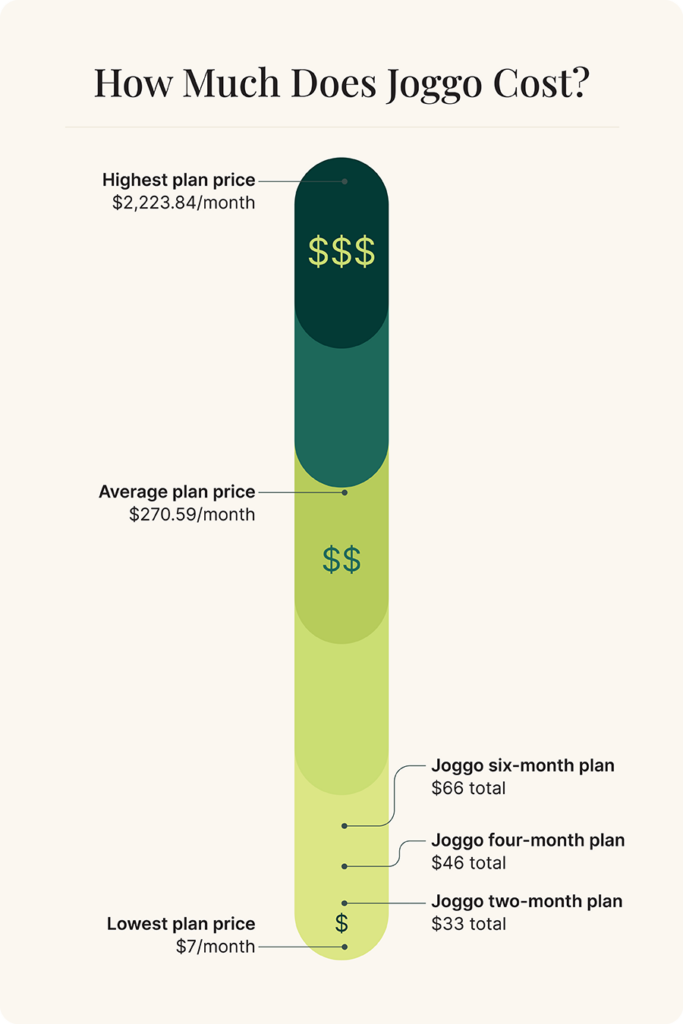
Joggo offers three different program lengths. Even if you don’t personalize a meal plan during the questionnaire, it comes with your purchase.
- Two months: $33
- Four months: $46
- Six months: $66
We don’t like that pricing is hidden with Joggo. The only way to find pricing is by completing the onboarding questionnaire, which collects your email before providing results and package options. Joggo also told us you could purchase an add-on subscription with more guidance around strengthening and recovery, but you can only access this subscription once you’ve been using the app for a while. Users will get the offer in an email or app notification and have a chance to upgrade for an additional $1.99 per week.
We also didn’t like that Joggo doesn’t offer a trial period. You must purchase a plan before entering the app, unlike Noom, which offers a one-to-two-week trial period so you can make sure it fits your schedule before purchasing.
But compared to other subscription weight loss platforms we’ve tested, including Weight Watchers and Noom, Joggo offers great value at a relatively low cost because it provides meal guidance and fitness education when others just offer the nutritional component for a similar price (or higher). Joggo lacks the coaching services that Weight Watchers and Noom offer, but the brand does plan to launch this function in the near future.
Joggo user reviews
The Handbook Team surveyed more than 100 Joggo users and discussed the platform with previous customers to better understand what real people got out of the app.
Of all survey respondents participating in Joggo’s weight loss program, 72.2 percent said the app was useful, and 56.4 percent said the program worked well with their schedule. As a result, most respondents agreed that they:
- Have better mental health (64.8 percent).
- Eat and feel healthier (72.3 percent and 64.9 percent, respectively).
- Lead a healthier lifestyle (67.5 percent).
- Got good value for what they paid (72.22 percent).
- Would recommend this program to a family member or friend (68.5 percent).
But when we asked monthlong Joggo participant Karly K. about her experience, she mentioned that she had more success reaching her running goals with Couch to 5K, a program for beginners that incrementally progresses participants from walking to running. “There was something about [Joggo’s] user interface that didn’t make sense to me. But I know other people have had success with it,” she says.
Similar to the findings during our testing, she pointed out inaccuracies with pace tracking on the iPhone. “The pace was always off compared to my Apple Watch runs,” she says. Our team agrees, finding Joggo’s tracking metrics more accurate using the Apple Watch rather than holding the phone during runs.
She also found the running streak feature problematic. “With Joggo, it felt like it was forcing you to run every day,” she says. Initially, our team noticed the same issue, not fully understanding the purpose of the streak. It seemed like it encouraged multiple run days in a row, which can cause overtraining and injury. But after talking to Joggo’s live agent, they explained how the streak tracked the completion of your self-selected run days only, not every workout day. We also noticed that Joggo released an update during our testing period to clearly label optional rest days outside of your running program. Not only does this send a better message to users, but it also shows us that Joggo is actively improving its user experience.
Mental health and self-monitoring weight loss
According to research, weight-loss apps can negatively affect your mental health when used incorrectly. Although Joggo doesn’t closely monitor your daily calorie counts, it does log your meals and workouts. According to Rickel, self-monitoring can be a powerful tool and motivator, but it’s easy for anyone to get fixated on numbers and results.
“Mental health professionals usually get concerned about any behavior when it starts to interfere with significant areas of functioning,” says Rickel. “With nutrition or fitness tracking, if someone finds that they are becoming overly anxious or depressed based on the metrics of their ‘achievements’ for the day, then it is worth taking a step back to evaluate whether the tracking is doing more harm than good.”
If you’re experiencing anxious behavior regarding your progress on any weight loss program, see a mental health professional to discuss healthier ways to measure progress.
Our final verdict
The Joggo running app is a good weight loss tool for those prioritizing healthy lifestyle changes, emphasizing consistent exercise and wholesome meals over calorie counting. But beware of the misleading onboarding process.
Unfortunately, Joggo’s onboarding questionnaire results give a poor first impression of the app because of its lofty weight loss goals. Rapid weight loss (like 6 pounds a week) is not only unhealthy but also unsafe, raising your risk for a loss of muscle mass, nutritional deficiencies, and gallstones. Additionally, the program’s maximum weight loss calorie recommendations were alarmingly low. Our testers were relieved to see that none of these unhealthy goals were transferred to our program and served more as a marketing gimmick. If you’re willing to overlook the initial quiz results page, the app actually offers sustainable weight loss methods.
We love how Joggo models a healthy lifestyle by offering delicious recipes and a realistic running program tailored to your activity level without the pressure to track every calorie eaten or burned. However, the $33–$66 total cost per month (depending on your plan’s length) could be hard to justify without a trial period to see if the program is right for you.
We wouldn’t recommend Joggo to anyone who has medical conditions that require professional clearance or oversight, like many heart conditions, due to its poor safety vetting and lack of clinical coaches. It’s a good idea to talk to your doctor first before starting a weight loss program to make sure it’s safe for you. And if you’ve tried weight loss programs on your own without sustained results, Rickel suggests recruiting more help if possible. Consulting a registered dietician, personal trainer, or mental health professional can help you overcome behavioral and motivational barriers for long-term success.
Frequently asked questions
Yes. The Joggo app is a legitimate fitness app that also caters to weight loss by offering tailored meal plans and running-focused exercise programs. It’s an easy-to-follow running plan for weight loss best suited to novice and aspiring joggers and runners.
Yes, you can participate in Joggo’s program as a walker, but it’s designed for people who would like to progress into jogging and running throughout the program.
Joggo can be used for sustainable weight loss because it models a healthy meal and exercise program without overemphasizing calorie counts and daily weight checks. However, your success depends on your commitment and discipline while using the app.
- Hall, K. D., & Kahan, S. (2018). Maintenance of lost weight and long-term management of obesity. Medical Clinics of North America, 102(1), 183–197. Link
- Benton, D., & Young, H. A. (2017). Reducing calorie intake may not help you lose body weight. Perspectives on Psychological Science, 12(5), 703–714. Link
- Eikey, E. V. (2021). Effects of diet and fitness apps on eating disorder behaviours: Qualitative study. BJPsych Open, 7(5). Link
- Hahn, S. L., Pacanowski, C. R., Loth, K. A., Miller, J., Eisenberg, M. E., & Neumark-Sztainer, D. (2021). Self-weighing among young adults: Who weighs themselves and for whom does weighing affect mood? A cross-sectional study of a population-based sample. Journal of Eating Disorders, 9(1). Link
- Losing weight. Centers for Disease Control and Prevention. (2023, June 15). Link
- Physical activity for a healthy weight. Centers for Disease Control and Prevention. (2023, April 26). Link
- Sani, S. H., Fathirezaie, Z., Brand, S., Pühse, U., Holsboer-Trachsler, E., Gerber, M., & Talepasand, S. (2016). Physical activity and self-esteem: Testing direct and indirect relationships associated with psychological and physical mechanisms. Neuropsychiatric Disease and Treatment, Volume 12, 2617–2625. Link
- Vink, R. G., Roumans, N. J., Arkenbosch, L. A., Mariman, E. C., & van Baak, M. A. (2016). The effect of rate of weight loss on long‐term weight regain in adults with overweight and obesity. Obesity, 24(2), 321–327. Link
- Calton, J. B. (2010). Prevalence of micronutrient deficiency in popular diet plans. Journal of the International Society of Sports Nutrition, 7(1). Link
- U.S. Department of Health and Human Services. (n.d.). Gallstones. National Institute of Diabetes and Digestive and Kidney Diseases. Link





